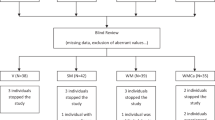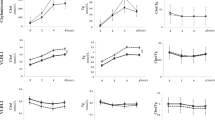Abstract
Background/Objectives:
Consumption of hydroxypropylmethylcellulose (HPMC), a viscous dietary fiber, lowers total cholesterol (TC) and low-density lipoprotein cholesterol (LDL-C). However, HPMC had not previously been studied in individuals receiving lipid drug therapy.
Subjects/Methods:
This randomized, double-blind crossover trial examined the lipid effects of HPMC in subjects with hypercholesterolemia on statin therapy. Men (n=5) and women (n=8) with LDL-C⩾2.59 mmol/l after at least 4 weeks of stable-dose statin therapy, and a mean age of 58.6 years, were enrolled. Subjects received twice daily doses of either 2.5 g HPMC or control, delivered in a lemonade beverage for 4 weeks, then crossed over to receive the opposite treatment for an additional 4 weeks.
Results:
Mean baseline concentrations of TC, non-high-density lipoprotein cholesterol (non-HDL-C), LDL-C, HDL-C, triglyceride (TG), TC/HDL-C ratio and apolipoprotein (Apo) B were 4.95, 3.63, 3.03, 1.33, 1.30 and 3.89 mmol/l and 1.00 g/l, respectively. HPMC consumption resulted in significantly larger reductions (P<0.01 vs control for all) in TC (−10.9 vs −3.5%), non-HDL-C (−12.8 vs −2.9%), LDL-C (−15.7 vs −5.1%), TC/HDL-C ratio (−5.3 vs +1.3%) and Apo B (−8.7 vs −3.9%). There were no differences between treatments for changes in HDL-C (−5.2 vs −4.3%) or TG (+3.9 vs +8.9%).
Conclusions:
These results support the view that HPMC is an effective adjunct to statin therapy for further lowering atherogenic lipids and lipoproteins in men and women with primary hypercholesterolemia.
This is a preview of subscription content, access via your institution
Access options
Subscribe to this journal
Receive 12 print issues and online access
$259.00 per year
only $21.58 per issue
Buy this article
- Purchase on Springer Link
- Instant access to full article PDF
Prices may be subject to local taxes which are calculated during checkout


Similar content being viewed by others
References
Agrawal AR, Tandon M, Sharma PL (2007). Effect of combining viscous fibre with lovastatin on serum lipids in normal human subjects. Int J Clin Pract 61, 1812–1818.
Albert MA, Danielson E, Rifai N, Ridker PM, for the PRINCE Investigators (2001). Effects of statin therapy on C-reactive protein levels. The Pravastatin Inflammation/CRP Evaluation (PRINCE): A randomized trial and cohort study. JAMA 286, 64–70.
Ajani UA, Ford ES, Mokdad AH (2004). Dietary fiber and C-reactive protein: Findings from National Health and Nutrition Examination Survey Data. J Nutr 134, 1181–1185.
Anderson JW, Davidson MH, Blonde L, Brown WV, Howard WJ, Ginsberg H et al. (2000). Long-term cholesterol lowering effects of psyllium as an adjunct to diet therapy in the treatment of hypercholesterolemia. Am J Clin Nutr 71, 1433–1438.
Ballantyne CM, Abate N, Yuan Z, King TR, Palmisano J (2005). Dose-comparison study of the combination of ezetimibe and simvastatin (Vytorin) versus atorvastatin in patients with hypercholesterolemia: the Vytorin Versus Atorvastatin (VYVA) study. Am Heart J 149, 464–473.
Ballantyne CM, Houri J, Notarbartolo A, Melani L, Lipka LJ, Suresh R et al. (2003). Effect of ezetimibe coadministered with atorvastatin in 628 patients with primary hypercholesterolemia: a prospective, randomized, double-blind trial. Circulation 107, 2409–2415.
Basu A, Devaraj S, Jialal I (2006). Dietary factors that promote or retard inflammation. Arterioscler Thromb Vasc Biol 26, 995–1001.
Bays H (2006). Statin safety: an overview and assessment of the data—2005. Am J Cardiol 97 (Suppl), 6C–26C.
Braun WH, Ramsey JC, Gehring PJ (1974). The lack of significant absorption of methylcellulose, viscosity 3300 CP, from the gastrointestinal tract following single and multiple oral doses to the rat. Food Cosmet Toxicol 12, 373–376.
Brown L, Roener B, Willett WW, Sacks FM (1999). Cholesterol-lowering effects of dietary fiber: a meta-analysis. Am J Clin Nutr 69, 30–42.
Buemann B, Toubro S, Ruben A, Astrup A (1999). Human tolerance to a single, high dose of D-tagatose. Regul Toxicol Pharmacol 29, 866–870.
Burdock GA (2007). Safety assessment of hydroxypropylmethylcellulose as a food ingredient. Food Chem Toxicol 45, 2341–2351.
Carr P, Gallaher DD, Yang C, Hassel CA (1996). Increased intestinal contents viscosity reduces cholesterol absorption efficiency in hamster fed hydroxypropylmethylcellulose. J Nutr 126, 1463–1469.
Castro Cabezas M, de Vries JH, Van Oostrom AJ, Iestra J, van Staveren WA (2006). Effects of a stanol-enriched diet on plasma cholesterol and triglycerides in patients treated with statins. J Am Diet Assoc 106, 1564–1569.
Davidson MH, Toth P, Weiss S, McKenney J, Hunninghake D, Isaacsohn J et al. (2001). Low-dose combination therapy with colesevelam hydrochloride and lovastatin effectively decreases low-density lipoprotein cholesterol in patients with primary hypercholesterolemia. Clin Cardiol 24, 467–474.
Davidson MH, Maki KC, Kong JC, Dugan LD, Torri SA, Hall HA et al. (1998). Long-term effects of consuming foods containing psyllium seed husk on serum lipids in subjects with hypercholesterolemia. Am J Clin Nutr 67, 367–376.
Davidson MH, Maki KC, Pearson TA, Pasternak RC, Deedwania PC, McKenney JM et al. (2005). Results of the National Cholesterol Education Program (NCEP) Evaluation ProjecT Utilizing Novel E-Technology (NEPTUNE) II survey and implications for treatment under the recent NCEP Writing Group recommendations. Am J Cardiol 96, 556–563.
Dressman JB, Adair CH, Barnett JL, Berardi R, Dunn-Kucharski VA, Jarvenpaa KM et al. (1993). High molecular-weight hydroxypropylmethylcellulose. Arch Intern Med 153, 1345–1353.
Erhardt LR, Hobbs FD (2007). A global survey of physicians’ perceptions on cholesterol management: the From The Heart study. Int J Clin Pract 61, 1078–1085.
Expert Panel on Detection, Evaluation, and Treatment of High Blood Cholesterol in Adults (2002). Third report of the national cholesterol education program (NCEP) expert panel on detection, evaluation, and treatment of high blood cholesterol in adults (adult treatment panel III) final report. Circulation 106, 3143–3421.
Friedewald WT, Levy RI, Fredrickson DS (1972). Estimation of the concentration of low-density lipoprotein cholesterol in plasma, without use of the preparative ultracentrifuge. Clin Chem 18, 499–502.
Glore SR, Van Treeck D, Knehans AW, Guild M (1994). Soluble fiber and serum lipids: a literature review. J Am Diet Assoc 94, 425–436.
Goldberg AC, Ostlund Jr RE, Bateman JH, Schimmoeller L, McPherson TB, Spilburg CA (2006). Effect of plant stanol tablets on low-density lipoprotein cholesterol lowering in patients on statin drugs. Am J Cardiol 97, 376–379.
Graham I, Atar D, Borch-Johnsen K, Boysen G, Burell G, Cifkova R et al. (2007). ESC Committee for Practice Guidelines. European guidelines on cardiovascular disease prevention in clinical practice: executive summary. Atherosclerosis 194, 1–45.
Grundy SM, Cleeman JI, Merz CN, Brewer Jr HB, Clark LT, Hunninghake DB et al. (2004). Implications of recent clinical trials for the National Cholesterol Education Program Adult Treatment Panel III Guidelines. J Am Coll Cardiol 44, 720–732.
Hunninghake DB, Miller VT, LaRosa JC, Kinosian B, Jacobson T, Brown V et al. (1994). Long-term treatment of hypercholesterolemia with dietary fiber. Am J Med 97, 501–503.
Jensen CD, Haskell W, Whittam JH (1997). Long-term effects of water-soluble dietary fiber in the management of hypercholesterolemia in healthy men and women. Am J Cardiol 79, 34–37.
Jones PH, Davidson MH, Stein EA, Bays HE, McKenney JM, Miller E et al. (2003). Comparisons of the efficacy and safety of rosuvastatin versus atorvastatin, simvastatin, and pravastatin across doses (STELLAR Trial). Am J Cardiol 92, 152–160.
King DE, Egan BM, Woolson RF, Mainous III AG, Al-Solaiman Y, Jesro A (2007). Effect of high-fiber diet vs a fiber-supplemented diet on C-reactive protein level. Arch Intern Med 167, 502–506.
Kinlay S (2007). Low-density lipoprotein dependent and independent effects of cholesterol-lowering therapies on C-reactive protein: A meta-analysis. J Am Coll Cardiol 49, 2003–2009.
Knopp RH, Superko HR, Davidson M, Insull W, Dujovne CA, Kwiterovich PO et al. (1999). Long-term blood cholesterol-lowering effects of a dietary fiber supplement. Am J Prev Med 17, 18–23.
Maki KC, Davidson MH, Malik KC, Albrecht HH, O’Mullane J, Daggy BP (1999). Cholesterol lowering with high-viscosity hydroxypropylmethylcellulose. Am J Cardiol 84, 1198–1203.
Maki KC, Davidson MH, Torri S, Ingram KA, O’Mullane J, Daggy BP et al. (2000). High-molecular-weight hydroxypropylmethylcellulose taken with or between meals is hypocholesterolemic in adult men. J Nutr 130, 1705–1710.
Maki KC, Carson ML, Miller MP, Turowski M, Wilder DM, Bell M et al. (2007). High-viscosity hydroxypropylmethylcellulose blunts postprandial glucose and insulin responses. Diabetes Care 30, 1039–1043.
Maki KC, Carson ML, Miller MP, Turowski M, Bell M, Wilder DM et al. (2008). Hydroxypropylmethylcellulose and methylcellulose consumption reduce postprandial insulinemia in overweight and obese men and women. J Nutr 138, 292–296.
Moreyra AE, Wilson AC, Koraym A (2005). Effect of combining psyllium fiber with simvastatin for lowering cholesterol. Arch Intern Med 165, 1161–1166.
Nissen SE, Tuzcu EM, Schoenhagen P, Crowe T, Sasiela WJ, Tsai J et al. (2005). Statin therapy, LDL cholesterol, C-reactive protein, and coronary artery disease. N Engl J Med 352, 29–38.
Pearson TA, Denke MA, McBride PE, Battisi WP, Brady WE, Palmisano J (2005). A community-based, randomized trial of ezetimibe added to statin therapy to attain NCEP ATP III goals for LDL cholesterol in hypercholesterolemic patients: the ezetimibe add-on to statin for effectiveness (EASE) trial. Mayo Clinic Proc 80, 587–595.
Pearson TA, Laurora I, Chu H, Kafonek S (2000). The Lipid Treatment Assessment Project (L-TAP): a multicenter survey to evaluate the percentages of dyslipidemic patients receiving lipid-lowering therapy and achieving low-density lipoprotein cholesterol goals. Arch Intern Med 160, 459–467.
Peters JR, Quiter ES, Brekke ML, Admire J, Brekke MJ, Mullis RM et al. (1994). The Eating Patterns Assessment Tool: a simple instrument for assessing dietary fat and cholesterol intake. J Am Diet Assoc 94, 1008–1013.
Pocock SJ (1983). Clinical Trials: A Practical Approach. Wiley Medical: New York.
Reppas C, Adair CH, Barnett JL, Berardi RR, DuRoss D, Swidan SZ et al. (1993). High viscosity hydroxypropylmethylcellulose reduces postprandial blood glucose concentrations in NIDDM patients. Diabetes Res Clin Pract 22, 61–69.
Reppas C, Greenwood DE, Dressman JB (1999). Longitudinal versus radial effects of hydroxypropylmethylcellulose on gastrointestinal glucose absorption in dogs. Eur J Pharmacol Sci 8, 211–219.
Reppas C, Meyer JH, Sirois PJ, Dressman JB (1991). Effects of hydroxypropylmethylcellulose on gastrointestinal transit time and luminal viscosity in dogs. Gastroenterology 100, 1217–1223.
Reppas C, Swidan SZ, Tobey SW, Turowski M, Dressman JB (2009). Hydroxypropylmethylcellulose significantly lowers blood cholesterol in mildly hypercholesterolemic human subjects. Eur J Clin Nutr 63, 71–77.
Santos EM (1986). Expert panel. Final report on the safety assessment of hydroxymethylcellulose, hydroxypropylcellulose, methylcellulose, hydroxypropylmethylcellulose, and cellulose gum. J Am Coll Toxicol 5, 1–59.
Todd PA, Benfield P, Goa KL (1990). Guar gum. A review of its pharmacological properties, and use as a dietary adjunct in hypercholesterolemia. Drugs 39, 917–928.
Topol EJ (2004). Intensive statin therapy—a sea change in cardiovascular prevention. N Engl J Med 350, 1562–1564.
United States Food and Drug Administration (1997). FDA final rule for federal labeling: health claims; oats and coronary heart disease. Fed Regist 62, 3584–3681.
United States Food and Drug Administration (1998). FDA final rule for federal labeling: health claims; soluble fiber from certain foods and coronary heart disease. Fed Regist 63, 8103–8121.
Vasudevan AR, Jones PH (2006). Effective use of combination lipid therapy. Curr Atheroscler Rep 8, 76–84.
Weickert MO, Pfeiffer AF (2008). Metabolic effects of dietary fiber consumption and prevention of diabetes. J Nutr 138, 439–442.
Acknowledgements
We acknowledge the assistance of Vicki Deyarmond at The Dow Chemical Company for assistance with study product distribution, as well as Franz Jones and Deborah C Herther for assistance with data collection. This study was sponsored by The Dow Chemical Company, Midland, MI, USA.
Author information
Authors and Affiliations
Corresponding author
Rights and permissions
About this article
Cite this article
Maki, K., Carson, M., Miller, M. et al. Hydroxypropylmethylcellulose lowers cholesterol in statin-treated men and women with primary hypercholesterolemia. Eur J Clin Nutr 63, 1001–1007 (2009). https://doi.org/10.1038/ejcn.2009.9
Received:
Revised:
Accepted:
Published:
Issue Date:
DOI: https://doi.org/10.1038/ejcn.2009.9



